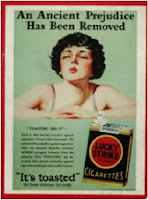COP LECTURE NOTES
CONSUMERISM
AIMS OF LECTURE:
- Analyse the rise of US consumerism
- Discuss the links between consumerism and our unconscious desires
- Sigmund Freud
- Edmund Bernays
- Consumerism as social control
Content of lecture mainly sourced from the above.
SIGMUND FREUD (1854-1939)
- New theory of human nature
- Psychoanalysis
- Hidden primitive sexual forces and animal instincts which need controlling
- The Interpretation of Dreams (1899)
- The Unconscious (1915)
- The Ego and the Id (1923)
- Beyond the Pleasure Principle (1920)
- Civilization & its Discontents (1930
- The unconcious is a strange and irrational place.

1930
- Fundamental tension between civilization and the individual
- Human instincts incompatible with the well being of community.
- The Pleasure Principle- If we can satiate our primitive desires, momentarily we are docile and happy
- civilisation will make us discontented as we cant live out our desires with in society.
EDWARD BERNAYS (1891-1995)
- Press Agent
- Employed by public information during WW1
- Post war- set up ‘The Council on Public Relations’
- Birth of PR
- Based on the ideas of Freud (his uncle).
- Crystallizing Public Opinion (1923)
- Propaganda (1928)
EASTER DAY PARADE
Employed by tobacco company to get woman to smoke, he paid lots of beautiful debutante to walk in the middle of New York parade. At an organized moment under the watchful eye of cameras the woman sparked up. He fed a story to the papers that these women were sufrigets the cigarettes became a symbol of sex appeal independance and freedom, breaking free of the oppression of men.
1924
- product placement
- Celebrity endorsements
- The use of pseudo-scientific reports
- Even presidents were involved
- Henry ford 1863-1947
- Transposes taylorism to car factories of Detroit
- Moving assembly line
- Standard production models built as they move through the factory
- Requires large investment, but increases productivity so much that relatively high wages can be paid, allowing the workers to buy the product they produce
THE MODEL T FORD 1908-1927
- 1910 – 20,000 produced, $850
- 1916 – 600,000, $360
- By 1927 – 15 million manufactured, $290
- Assembly time reduced from 12.5 to 1.5 hours
MARKETING HIDDEN NEEDS
VANCE PACKARD
- Selling emotional security
- Selling reassurance of worth
- Selling ego-gratification
- Selling Creative Outlets
- Selling Love Objects
- Selling sense of power
- Selling a sense of roots
- Selling immortality
1920
A new elite is needed to manage the bewildered herd
Manufacturing consent
Governmental propaganda in order to control its own people.
RUSSIAN REVOLUTION 1917
Over threw the wealthy rich and created a communist nation ran by the people and distributing wealth fairly amongst the people.

















No comments:
Post a Comment